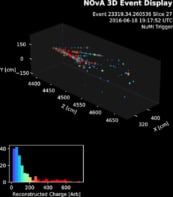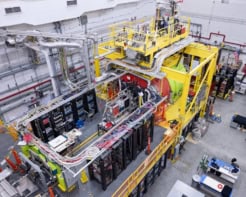A company is seeking permission to search for oil in the UK using “microleptons” – particles that are completely unknown to high-energy physicists. Technology Investment and Exploration Limited (TIEL) has already won outline planning permission from the local council to build a borehole at a site in rural Leicestershire, and has secured an oil-exploration licence from the UK government.
TIEL believes that conventional satellite photographs of the Earth contain recordings of invisible microleptons emitted by underground deposits of oil. These areas can be revealed, the company says, by shining a “microlepton generator” onto the photographic film. Having identified an area of interest, TIEL flies over the target area in a small plane or helicopter with a portable “microlepton scanner” on board to identify the exact location of the oil.
Nicholas Yellachich, UK managing director of the firm, told Physics World that the technology is based on work carried out by Martin Perl, who shared the 1995 Nobel Prize for Physics for his discovery of the tau lepton. But Perl denies any connection with the work. “The claims are nonsense, and they have nothing to do with my work,” he says.
According to Alkor International – a rival firm that claims to have found oil using the same technique – microleptons are “very small members of the lepton family”. They are supposed to be about 1000 times less massive than the electron, which is the lightest of the leptons. Millions of microleptons are said to surround every proton and electron in an atom, and – according to Alkor’s website – they can form billion-strong clusters that pass unhindered through materials faster than the speed of light.
Physicists have been quick to ridicule the technology. “If microleptons existed, we would have detected them a long time ago,” says John Dowell, a particle physicist at Birmingham University. “If microleptons did exist and could pass through thousands of metres of rock, how can they be detected so easily by a hand-held detector on board a helicopter?” Dowell has written to Leicestershire County Council pointing out the scientific flaws of the company’s technology. “But the council decided to give outline planning permission anyway, ” he says.
Local residents – spearheaded by the Charnwood Forest Oil Action Group – are furious about the company’s plans. They have been in contact with Robin Marshall, a particle physicist at Manchester University. He discovered that microlepton technology is based on a paper published by a Russian physicist called Anatoly Okhatrin in the journal Doklady in 1989. “He was clearly either mad, drunk or deluded,” says Marshall. “He spun a cone of lead weighing several kilograms in front of a pin-hole camera and claimed to have photographed a ‘glow’ surrounding the cone that was due to microleptons.”
It is still unclear why TIEL wants to search for oil in Britain. One theory is that a drilling licence from the British government could be used as a stamp of approval when marketing the technology elsewhere in the world. “It is strange that an oil company is relying on bogus technology”, says Davidson, “when all the available geological evidence suggests there is no oil to be found.”



